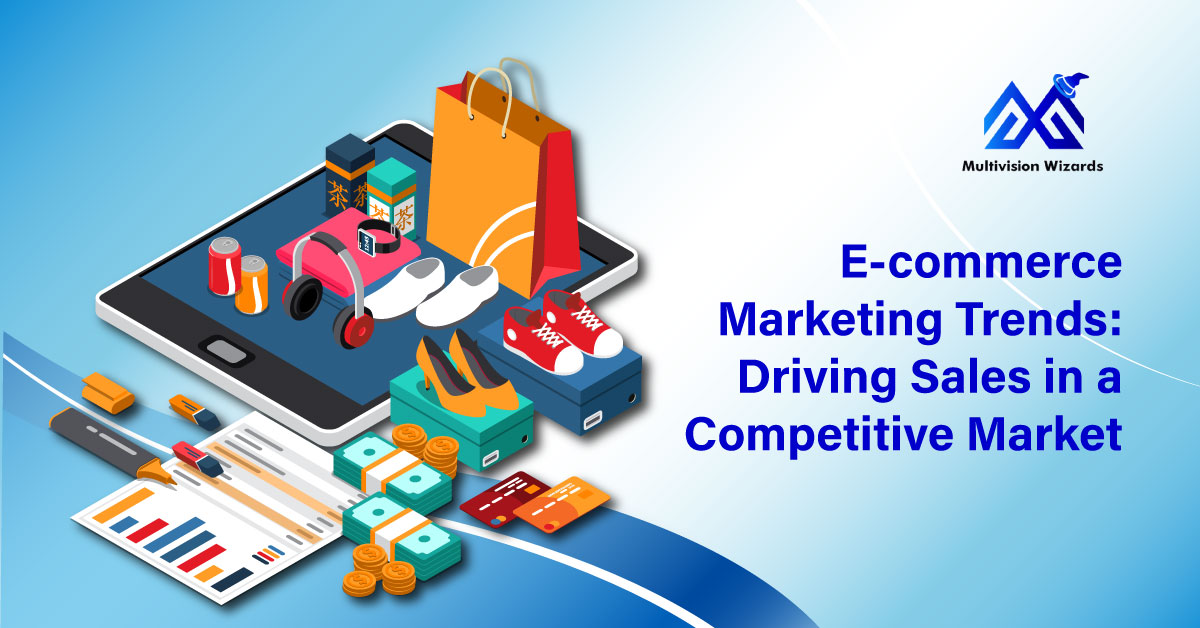E-commerce Marketing Trends: Driving Sales in a Competitive Market
Shopping habits of customers have evolved considerably in recent years. E-commerce has firmly established itself as a preferred shopping platform in the modern age, allowing consumers to shop for a myriad of products ranging from groceries and gadgets to fashion and fitness. Along with modern conveniences comes heavy competition. The era of having to choose between either local offline shops or global brands is over because now they all compete online. This intense competition is a direct result of global players entering even the tiniest markets.
This shift means that the success of an e-commerce business hinges on the effectiveness of its marketing. In today’s world, customers can move to a rival brand in a single tap, which means the strategy to capture their attention has to be more focused, faster, and built on a deeper understanding of the target audience than ever before.

At Multivision Wizards top digital marketing company in noida, we partner with organizations to understand the above challenges, create effective strategies, and ensure companies succeed in attracting, converting, and keeping their clientele in this difficult market. Let’s analyse the trends in e-commerce marketing that will be relevant in 2025 and further.
Why E-commerce Marketing is the Backbone of Online Success
E-commerce marketing isn’t just about running ads or posting on social media—it’s about creating a seamless experience across platforms, ensuring that customers remember your brand, and giving them compelling reasons to buy from you.
Think about it: when a customer has hundreds of options for the same product, why should they pick yours? The answer lies in:
- How visible you are online.
- How well you engage with your audience.
- How smooth and personalized their shopping journey feels.
In short, the smarter your e-commerce marketing, the higher your chances of driving sales and building loyalty.
Key E-commerce Marketing Trends Driving Sales in 2025
-
Personalization at Scale: Making Customers Feel Valued
Customers today are flooded with offers and promotions. What stands out is personal relevance. If your store remembers what a customer purchased last month and recommends a product that complements it, you are more likely to make a sale.
How Personalization Works:
- Product recommendations based on browsing history.
- Personalized email campaigns tailored to customer interests.
- Location-based offers that make promotions more relevant.
Example: Amazon’s recommendation engine is a prime example of personalization at scale—it contributes to a large percentage of their revenue because customers feel like the platform “knows” them.
Why It Matters: Personalization reduces choice overload, builds trust, and increases the chances of repeat sales. In fact, studies show that customers are 80% more likely to buy from brands that offer personalized experiences.
-
Short-Form Video Shoppable Content: Where Entertainment Meets Shopping
Scrolling through Instagram Reels or TikTok has become a daily habit for millions. The e-commerce industry has capitalized on this by introducing shoppable content—where a customer can watch a product demo and purchase instantly without leaving the app.
How Businesses Can Use This:
- Create 15–30 second videos showcasing product benefits.
- Collaborate with influencers to demonstrate real use cases.
- Use built-in “Shop Now” buttons to allow instant checkout.
Example: Fashion and beauty brands like Zara and Nykaa have mastered this trend by using Instagram Reels where viewers can click and buy products instantly.
Why It Matters: Video creates emotional engagement, and when combined with shopping, it drastically reduces the gap between discovery and purchase.
-
Omnichannel Marketing: Consistency Across Every Touchpoint
Today’s customers move fluidly between devices and platforms. An omnichannel marketing strategy ensures that the experience feels connected.
What it Involves:
- Uniform branding and messaging across channels.
- Linking online and offline shopping experiences.
- Retargeting customers with consistent offers across devices.
Example: Starbucks integrates app, website, and in-store promotions so customers get a cohesive experience.
Why It Matters: Omnichannel marketing improves customer retention by offering a cohesive brand journey, no matter where or how customers engage.
-
Voice Search Conversational Commerce: Shopping with Just a Command
With the rise of smart assistants like Alexa, Siri, and Google Assistant, voice search has become a game-changer in e-commerce.
How to Optimize for Voice Search:
- Use conversational, long-tail keywords in product descriptions.
- Add FAQs that match how people speak rather than type.
- Ensure local SEO is voice-friendly (e.g., “near me” searches).
Why It Matters: Voice search is expected to make up a significant percentage of all searches in 2025. Being optimized means you capture customers at the exact moment of intent.
-
Social Commerce: Turning Browsers into Buyers
Social platforms are no longer just for discovery—they are now full-fledged shopping destinations.
How to Use Social Commerce:
- Add a storefront on platforms like Instagram and Facebook.
- Use influencer collaborations to drive authentic sales.
- Offer exclusive discounts for in-platform purchases.
Why It Matters: Social commerce reduces friction, making shopping faster and easier—especially effective for impulse purchases.
-
Sustainability and Ethical Branding: Winning the Conscious Consumer
Modern customers, especially younger demographics, prefer brands that align with their values. Sustainable practices and ethical branding are no longer optional.
Ways to Implement:
- Highlight eco-friendly packaging.
- Showcase ethical sourcing of materials.
- Be transparent about business practices.
Example: Brands like Patagonia have built loyal communities by focusing on environmental responsibility.
Why It Matters: Sustainability builds emotional connections and positions your brand as trustworthy and future-focused.
-
Retargeting Smarter Paid Ads: Winning Back Lost Customers
Many customers browse products, add them to carts, and then drop off without purchasing. Retargeting campaigns are essential to bring them back.
Effective Retargeting Strategies:
- Show ads with abandoned cart items.
- Offer discounts for returning to checkout.
- Use dynamic ads that showcase products based on past browsing.
Why It Matters: Retargeting is cost-effective because it focuses on warm audiences—people who have already shown interest in your brand.
-
Data-Driven Insights Predictive Analytics: Smarter Decisions for Growth
Instead of relying on guesswork, businesses are using predictive analytics to anticipate what customers will want next.
How It Works:
- Analyze past purchase patterns.
- Use data to predict seasonal demand.
- Plan inventory and campaigns based on future trends.
Why It Matters: Brands that leverage predictive insights can launch campaigns before competitors and keep their supply chain ready for upcoming demand.
-
Subscription Models Loyalty Programs: Creating Long-Term Value
Customers today don’t just want to buy—they want to belong. Subscription models and loyalty programs ensure consistent sales and keep customers tied to your brand.
Ideas for E-commerce:
- Subscription boxes with curated products.
- Loyalty points for repeat purchases.
- Exclusive member discounts.
Example: Beauty subscription boxes like “Fab Bag” in India thrive on this model.
Why It Matters: It turns one-time buyers into repeat customers, increasing lifetime customer value.
-
Enhanced Customer Experience: The Final Differentiator
All the marketing in the world won’t work if customers have a poor experience. Quick-loading websites, simple checkout processes, and responsive customer support make the difference between a lost lead and a loyal buyer.
What Enhances CX:
- 24/7 chatbot or live chat support.
- Easy return and refund policies.
- Mobile-first website design.
Why It Matters: Customer experience is the ultimate competitive advantage. Happy customers not only buy again but also recommend your brand to others.
Building a Winning Strategy with Multivision Wizards
Adopting these trends requires more than just awareness—it demands strategic execution. From creating personalized campaigns to leveraging predictive data and social commerce, brands need expert support to stay competitive.
At Multivision Wizards, we design e-commerce marketing strategies that blend creativity with data, ensuring your brand not only attracts attention but also drives consistent sales growth.
Conclusion
Ecommerce marketing in 2025 will revolve around personalization, social commerce, sustainable practices, predictive analytics, and the overall customer experience. Brands that capitalize on these trends will prosper, but those that fail to do so will get lost in the shuffle. There will always be competition but having the right digital marketing company set you apart and make sure that you are the one leading and not just participating.
Practical 10-Point Checklist for Immediate Action
- 1. Audit personalization touchpoints (recommendations, emails, post-purchase offers).
- 2. Create a short-form video content calendar for product demos and shoppable clips.
- 3. Ensure brand messaging and offers are synced across website, app, and social channels.
- 4. Optimize top-selling product pages for conversational/voice queries and long-tail phrases.
- 5. Enable storefronts on key social platforms and test in-app checkout flows.
- 6. Highlight at least one sustainability practice on product pages (packaging, sourcing).
- 7. Set up dynamic retargeting for cart abandoners with 24–48 hour follow-up creatives.
- 8. Implement basic predictive analytics to forecast demand for your top 10 SKUs.
- 9. Design a simple loyalty program (points or subscription pilot) and promote it site-wide.
- 10. Run a UX audit focused on mobile checkout speed and reduce friction points.
Use this checklist as a starter kit to translate these trends into measurable actions. If you'd like, Multivision Wizards can help tailor and implement these items for your brand.


